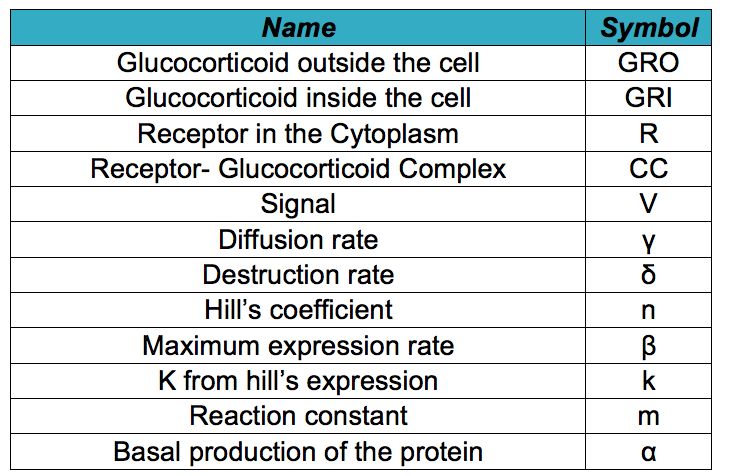Team:Colombia Uniandes/Modeling
From 2013.igem.org
(→Glucocorticoid sensor) |
(→Glucocorticoid sensor) |
||
| Line 36: | Line 36: | ||
<li><b>GRI: </b> The amount of glucocorticoids inside the yeast cell, depends on the degradation rate of the hormone, the complex formation and the import rate of the glucocorticoids inside the cell, which depends on the diffusion rate of the hormone in relation with the concentration of the hormone outside and inside the cell. | <li><b>GRI: </b> The amount of glucocorticoids inside the yeast cell, depends on the degradation rate of the hormone, the complex formation and the import rate of the glucocorticoids inside the cell, which depends on the diffusion rate of the hormone in relation with the concentration of the hormone outside and inside the cell. | ||
| - | [[File:RxnGC.png|center| | + | [[File:RxnGC.png|center|400x250px]] |
| - | + | ||
| - | + | ||
| - | + | ||
| + | [[File:GRI.png|center|600x300px]] | ||
| + | </li> | ||
| - | + | <li><b>R: </b> The receptor’s production in the cytoplasm is regulated by a constitutive promoter. This protein binds to the glucocorticoid and forms a dimer. So its concentration on the cell depends of the basal production, the complex production and the degradation rate. | |
| + | |||
| + | [[File:Recep.png|center|600x300px]] | ||
| + | |||
| + | </li> | ||
</ul> | </ul> | ||
Revision as of 22:00, 17 July 2013
Diferential ecuations
We use the mathematical model to check if the design works, before starting to work at the lab. To develop this model the first step is the do the deterministic model, which is based in differential equations. This type of model describe the mean behaviour for each of the substances in the synthetic circuit over time. However, it does not take into account the probabilities involved in each of the events described, the population interactions and the noise of the system.
The deterministic model is based in the law of mass conservation and expresses the inputs and outputs of the system with expressions that use the law of mass action and known models like HIll's or Michaelis Menten.
Below are shown and explained the differential equations that allowed us to work in both projects:
Glucocorticoid sensor
Below it is shown how differential equations for the Glucocorticoid Sensor based in the circuit shown in the project description . However, before describing the modeled system ,it is necessary to know all the symbols that will be use in the documents and the simulation. The following table contains all the substances involved in the processes and the constants required for the simulation.
- GRO: Animals release glucocorticoids under stress situations such as famine, injuries, anxiety or fear. This hormone is the one we will detect as an indicator of stressful conditions for the animal. This differential equation expresses the concentration of glucocorticoids outside the cell, which only depends on the diffusion rate of it into the cell
- GRI: The amount of glucocorticoids inside the yeast cell, depends on the degradation rate of the hormone, the complex formation and the import rate of the glucocorticoids inside the cell, which depends on the diffusion rate of the hormone in relation with the concentration of the hormone outside and inside the cell.
- R: The receptor’s production in the cytoplasm is regulated by a constitutive promoter. This protein binds to the glucocorticoid and forms a dimer. So its concentration on the cell depends of the basal production, the complex production and the degradation rate.
 "
"








